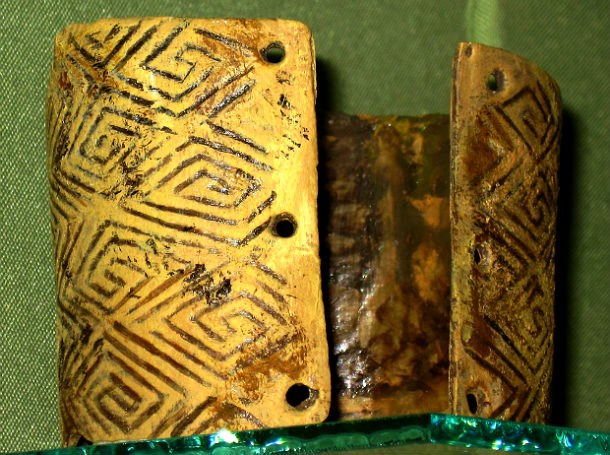The village Mizyn in Ukraine beautiful bracelets were found with mammoth bones, bent in an unknown way. Their age is 18,000 years BC. is.
Soviet scientist, Ph.D. Boris Frolov drew attention to the wonderful works of art of the Stone Age - two bracelets of mammoth bones found back in 1908 in the parking lot verhnopaleolitychniy Mizyn (right bank of the Desna River near Novgorod-Seversky Chernihiv region). Surfaces bracelets decorated old master complex ornamentation resembling ancient Greek meander pattern. The study led them to believe that it is nothing like calendars twenty-year-old!
Ornament has five zones, three of which carried "Meander", and two - zigzags. A total of 30 zones of meanders, each of them consisting of 12 lines. Total of 360 lines Frolov recalled that priests astronomers of ancient Egypt, the duration is distributed for 12 months, and each month - for 30 days. They added five "extra" days that were not included in any month and created about Memorial. So, the Egyptian tradition started back in the Stone Age?
Subsequently, a researcher engaged in these two areas, which consist of zigzag lines. In the first - zigzags 6 to 7 lines in each, so 42 line. The second zone - the zigzags 8 or 56 lines. In general - 14 zigzags, 98 lines. Frolov knew of archaic lunar calendar described ethnographer E. Orlova, who until recently enjoyed the Chukchi. It consisted of 14 weeks to 7 days total - 98 days. Ethnographers described as lunar calendar of 10 synodic months it used the North American Indians (tribes arapaho, squares, etc.). Indians scientist explained that this calendar best matches of a human being (for her, say, 10 fingers and toes, pregnancy lasts 10 synodic months, etc.). Perhaps this ancient lunar calendar of our ancestors related origin of our decimal number system.
But on mizynskomu bracelet inscribed with lines 564, ie 20 synodic months! How to explain this? Based on the hypothesis that our ancient ancestors counted the day and night hours, Frolov believes that there is not 20, but only 10 synodic months, as in the Indian calendar. Further, if two "extra" zigzags to connect one area to another area, then it will be 282 lines, that is - is 10 synodic months. A total of three zones contain 366 lines - the number of days in the solar year. Thus, bracelet mizynskomu see quite successful attempt to mix the solar and lunar calendars. It is possible that this principle was the basis of calendar Egyptians, Babylonians, Chukchi, North American Indians and others. So far today we can not solve the method by which the ancient inhabitants used their astronomical Mizyn "instruments" -brasletamy. Because they lived in a different environment, and their combined thinking such things that for us are alone - sociology, physiology, ethics, aesthetics and so on.
![]()
Bracelet with Mizyn
Based on the book "Mysteries of antiquity. Gaps in the history of civilization. "
Gary Burhanskyy, Rostislav Furduy. Kyiv, "Rainbow", 1988.
Soviet scientist, Ph.D. Boris Frolov drew attention to the wonderful works of art of the Stone Age - two bracelets of mammoth bones found back in 1908 in the parking lot verhnopaleolitychniy Mizyn (right bank of the Desna River near Novgorod-Seversky Chernihiv region). Surfaces bracelets decorated old master complex ornamentation resembling ancient Greek meander pattern. The study led them to believe that it is nothing like calendars twenty-year-old!
Ornament has five zones, three of which carried "Meander", and two - zigzags. A total of 30 zones of meanders, each of them consisting of 12 lines. Total of 360 lines Frolov recalled that priests astronomers of ancient Egypt, the duration is distributed for 12 months, and each month - for 30 days. They added five "extra" days that were not included in any month and created about Memorial. So, the Egyptian tradition started back in the Stone Age?
Subsequently, a researcher engaged in these two areas, which consist of zigzag lines. In the first - zigzags 6 to 7 lines in each, so 42 line. The second zone - the zigzags 8 or 56 lines. In general - 14 zigzags, 98 lines. Frolov knew of archaic lunar calendar described ethnographer E. Orlova, who until recently enjoyed the Chukchi. It consisted of 14 weeks to 7 days total - 98 days. Ethnographers described as lunar calendar of 10 synodic months it used the North American Indians (tribes arapaho, squares, etc.). Indians scientist explained that this calendar best matches of a human being (for her, say, 10 fingers and toes, pregnancy lasts 10 synodic months, etc.). Perhaps this ancient lunar calendar of our ancestors related origin of our decimal number system.
But on mizynskomu bracelet inscribed with lines 564, ie 20 synodic months! How to explain this? Based on the hypothesis that our ancient ancestors counted the day and night hours, Frolov believes that there is not 20, but only 10 synodic months, as in the Indian calendar. Further, if two "extra" zigzags to connect one area to another area, then it will be 282 lines, that is - is 10 synodic months. A total of three zones contain 366 lines - the number of days in the solar year. Thus, bracelet mizynskomu see quite successful attempt to mix the solar and lunar calendars. It is possible that this principle was the basis of calendar Egyptians, Babylonians, Chukchi, North American Indians and others. So far today we can not solve the method by which the ancient inhabitants used their astronomical Mizyn "instruments" -brasletamy. Because they lived in a different environment, and their combined thinking such things that for us are alone - sociology, physiology, ethics, aesthetics and so on.

Bracelet with Mizyn
Based on the book "Mysteries of antiquity. Gaps in the history of civilization. "
Gary Burhanskyy, Rostislav Furduy. Kyiv, "Rainbow", 1988.

















